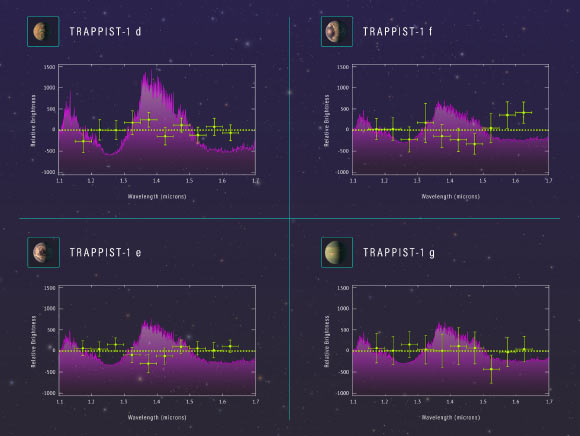Astronomers using the NASA/ESA Hubble Space Telescope have conducted the first spectroscopic survey of exoplanets within the habitable zone around TRAPPIST-1. Published in the journal Nature Astronomy, the results further support the terrestrial and potentially habitable nature of three of the studied planets.
The ultracool dwarf star TRAPPIST-1 hosts a total of seven known Earth-sized planets.
Three of the planets — TRAPPIST-1e, f and g — orbit within the system’s habitable zone, the region at a distance from the star where liquid water could exist on the surface of a planet. The fourth planet — TRAPPIST-1d — orbits in a borderline region at the inner edge of the habitable zone.
The new Hubble data rule out a cloud-free hydrogen-rich atmosphere for three of the planets — but for the TRAPPIST-1g such an atmosphere could not be excluded.
“The presence of puffy, hydrogen-dominated atmospheres would have indicated that these planets are more likely gaseous worlds like Neptune,” said MIT astronomer Dr. Julien de Wit, lead author on the study.
“The lack of hydrogen in their atmospheres further supports theories about the planets being terrestrial in nature.”
“This discovery is an important step towards determining if the planets might harbor liquid water on their surfaces, which could enable them to support living organisms.”
The observations were made while the planets were in transit in front of TRAPPIST-1. In this configuration a small section of the star’s light passes through the atmosphere of the planet and interacts with the atoms and molecules in it. This leaves a weak fingerprint of the atmosphere in the spectrum of the star.
While the results rule out one type of atmosphere, many alternative atmospheric scenarios are still consistent with the data gathered by the authors.

These spectra show the chemical makeup of the atmospheres of four of the Earth-sized planets orbiting within or near the habitable zone of the star TRAPPIST-1. To obtain the spectra, astronomers used Hubble to collect light from TRAPPIST-1 passing through the exoplanets’ atmospheres as the exoplanets crossed in front of the star. The purple curves show the predicted signatures of gases such as water and methane that absorb certain wavelengths of light. These gases would be found in a puffy hydrogen-dominated atmosphere similar to those of gaseous planets such as Neptune. The Hubble results, indicated by the green crosses, reveal no evidence of an extended atmosphere in three of the exoplanets (TRAPPIST-1d, f, and e). Additional observations are needed to rule out a hydrogen-dominated atmosphere for the fourth planet (TRAPPIST-1g). The evidence indicates that the atmospheres are more compact than could be measured by the Hubble observations. Image credit: NASA / ESA / Z. Levy, STScI.
“Although Hubble did not find evidence of hydrogen, we suspect the planetary atmospheres could have contained this lightweight gaseous element when they first formed,” they said.
“The planets may have formed farther away from their parent star in a colder region of the gaseous protostellar disk that once encircled the infant star.”
“The system is dynamically stable now, but the planets could not have formed in this tight pack,” said co-author Dr. Nikole Lewis, from the Space Telescope Science Institute.
“They’re too close together now, so they must have migrated to where we see them. Their primordial atmospheres, largely composed of hydrogen, could have boiled away as they got closer to the star, and then the planets formed secondary atmospheres.”
In contrast, Solar System’s rocky planets likely formed in the hotter, dryer region closer to the Sun.
“There are no analogs in our Solar System for these planets,” said co-author Dr. Hannah Wakeford, also from the Space Telescope Science Institute.
“One of the things researchers are finding is that many of the more common exoplanets don’t have analogs in our Solar System. So the Hubble observations are a unique opportunity to probe an unusual system.”
By ruling out the presence of a large abundance of hydrogen in the planets’ atmospheres, Hubble is helping to pave the way for the NASA/ESA/CSA James Webb Space Telescope.
“Spectroscopic observations of the TRAPPIST-1 planets with the next generation of telescopes will allow us to probe deeper into their atmospheres,” said co-author Dr. Michael Gillon, from the University of Líege.
“This will allow us to search for heavier gases such as carbon, methane, water, and oxygen, which could offer biosignatures for life.”
_____
Julien de Wit et al. Atmospheric reconnaissance of the habitable-zone Earth-sized planets orbiting TRAPPIST-1. Nature Astronomy, published online February 5, 2018; doi: 10.1038/s41550-017-0374-z








